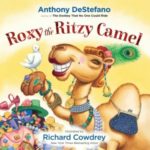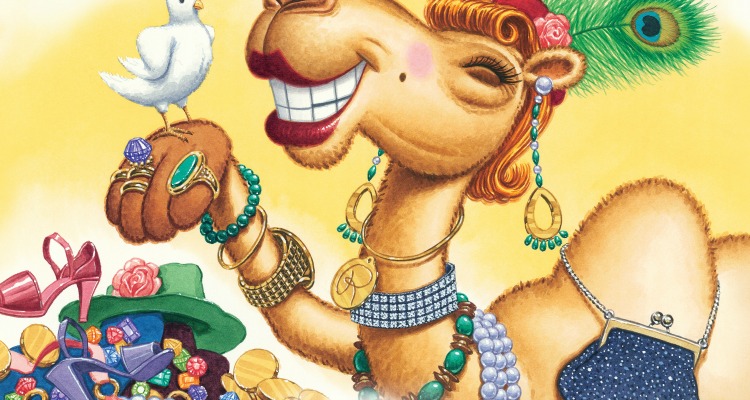In the children’s book Roxy the Ritzy Camel (Harvest House), author Anthony DeStefano and illustrator Richard Cowdrey relate the tale of a vain and possession-loving camel to demonstrate the familiar Bible verse: It is easier for a camel to go through the eye of a needle than for a rich man to enter the kingdom of God. In this Q&A, Anthony explains their goals with the book, why they chose to illustrate this particular passage from the Bible, and the challenges of writing for children…
Q: What were your goals writing Roxy the Ritzy Camel ?
?
I wanted to reach both adults and children with a very important message. Kids always have to deal with issues relating to selfishness and jealousy and not getting what they want. It’s crucial that they learn from a very early age the necessity of sharing and being generous. Adults have to deal with those same issues. Only they’re even more prone to becoming addicted to material possessions and status symbols.
In a sense, we’re all “camels in a desert.” There are lots of shiny and attractive trinkets that we get attached to—things that distract us from the true meaning of life. On some level we all have a “thirst” (as Roxy does), for the life-giving water which the Gospels speak about. And that thirst can only be fully satisfied by God when we get to Heaven. But we can have a taste of that water even now—in this life—by giving of ourselves and sacrificing for others, the way that Christ did. That’s the only real road to happiness. And the earlier children are taught that lesson, the better.
Q: What about this particular “eye of the needle” verse inspired you to bring it to life in this way?
Well, the verse is usually thought of as one of Christ’s so-called “hard sayings.” So I’ve always been intrigued by its deeper meaning. Also, the physical image of a camel trying to get through the eye of a needle is very striking—and also quite funny! The humor struck me one time as I was reading the Bible, and I said to myself—this might make children laugh if it were illustrated in the right way.
Then I learned that the “eye of the needle” is also thought to be a small entranceway in the ancient Gate of Jerusalem, which was opened at night when the main entrance was closed. In order for camels to get through this gate, they had to stoop low and have all their baggage removed. When I read this, it immediately struck me that this would be a great way to teach children and adults a lesson about humility and sharing and the true meaning of joy—and it could be done in a very lighthearted, humorous way.
Q: How do you get into the right frame of mind to write for that age group?
Actually, it’s the other way around. When I get up in the morning I have to try to put myself into the frame of mind of being a responsible, mature adult! It’s very easy for me to make up funny, childish rhymes and think of silly situations that will make kids laugh. The reason is I still think of myself as a kid. I’ve never been able to shake off that feeling of youthful immaturity. It’s very hard for me to believe that I’m actually a middle age man with lots of obligations and responsibilities and deadlines. So when I’m writing a children’s book, I just indulge my desire to play—it’s very easy and natural for me. It’s only when I’m writing the deeper, more meaningful and symbolic parts of the book that I have to try to put on my “mature, adult hat.”
Q: What was your process working with your illustrator, Richard Cowdrey?
This is the fourth children’s book I’ve done with Richard. The process is usually the same. First, I send him the text of the story, which always comes before anything. Then, I have several long conversations with him in which I give him my “vision” for the work as a whole. I tell him how I would like the book to “look” in general. Depending on the subject matter, for instance, I might tell him the illustrations should be done in the very artistic, serious, and realistic style of the old Walt Disney cartoons (like Snow White). Other times (as with Roxy) I’ll tell him the illustrations should be done in the funnier, more slapstick style of the old Warner Brothers cartoons (e.g., Bugs Bunny and Daffy Duck).
Once we agree on the approach, I’ll usually send him whatever ideas I have for different “scenes” in the book. I always have a lot of definite ideas because I think in a very visual way—even when I’m initially writing the book, I “see” many of the images in my mind. Of course Richard is a very brilliant illustrator, so he will have his own ideas as well—and many times they are better than mine. He’ll send me rough sketches of all the scenes, laid out with text, and we’ll go back and forth on the phone until we agree on everything. Then he will work on detailed sketches, which I also get to see and approve before he moves on the painting stage. It’s a very collaborative process, and one that the both of us enjoy very much.
Q: You write adult books and children’s books. How do you decide when it’s time to write one or the other?
 Everything is driven by the ideas that I happen to have. If I come up with an idea for a good children’s book, I’ll write that. If I have an idea for a good adult book, I’ll try to see if there is a publisher interested and work on that. As a general rule, it’s much easier and also more fun to write children’s books. However, it’s also much harder to come up with an original idea for a children’s book.
Everything is driven by the ideas that I happen to have. If I come up with an idea for a good children’s book, I’ll write that. If I have an idea for a good adult book, I’ll try to see if there is a publisher interested and work on that. As a general rule, it’s much easier and also more fun to write children’s books. However, it’s also much harder to come up with an original idea for a children’s book.
The topics for adult books come easier, but the actual planning, researching and writing is very difficult. I average about one adult book every three or four years, whereas I can write a children’s book in a few weeks—IF I come up with a good idea. But that’s a very big IF! The real truth, however, is that ALL of my books—even the kids books—are written with adults in mind. The kids books are usually loaded with a lot of symbolism. In fact, there’s sometimes more symbolism in one of my children’s books than in a Fellini movie! I do this so that the adults who are reading the books to their children or grandchildren might be challenged as well.
For instance, in Roxy: Water represents true life and grace, the desert is the world, “40 days and 40 nights” is the journey of life, full of struggling, the “fabulous city” with streets paved with Gold, is Heaven, the dove is Holy Spirit, all the other animals helping Roxy represent all the people of God who help us on our journey, the King of Kings is Jesus, etc.


